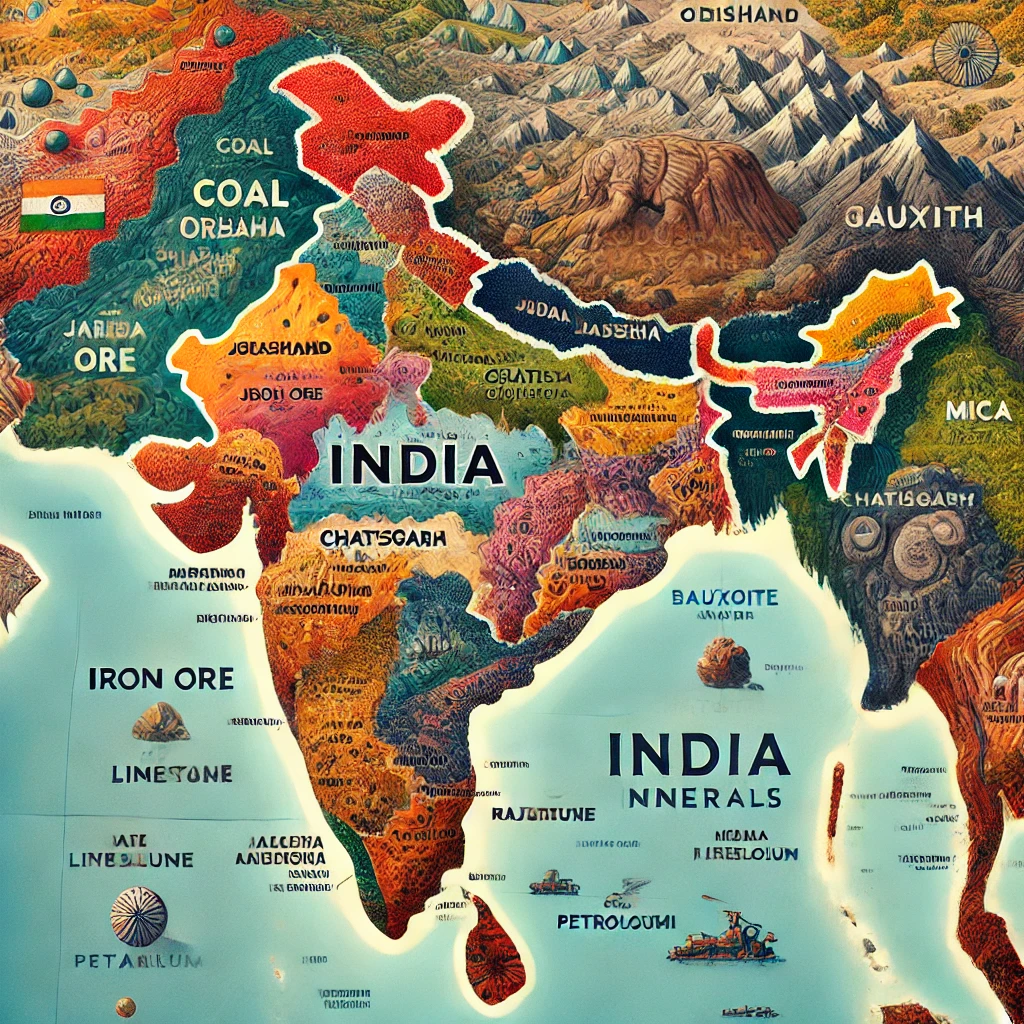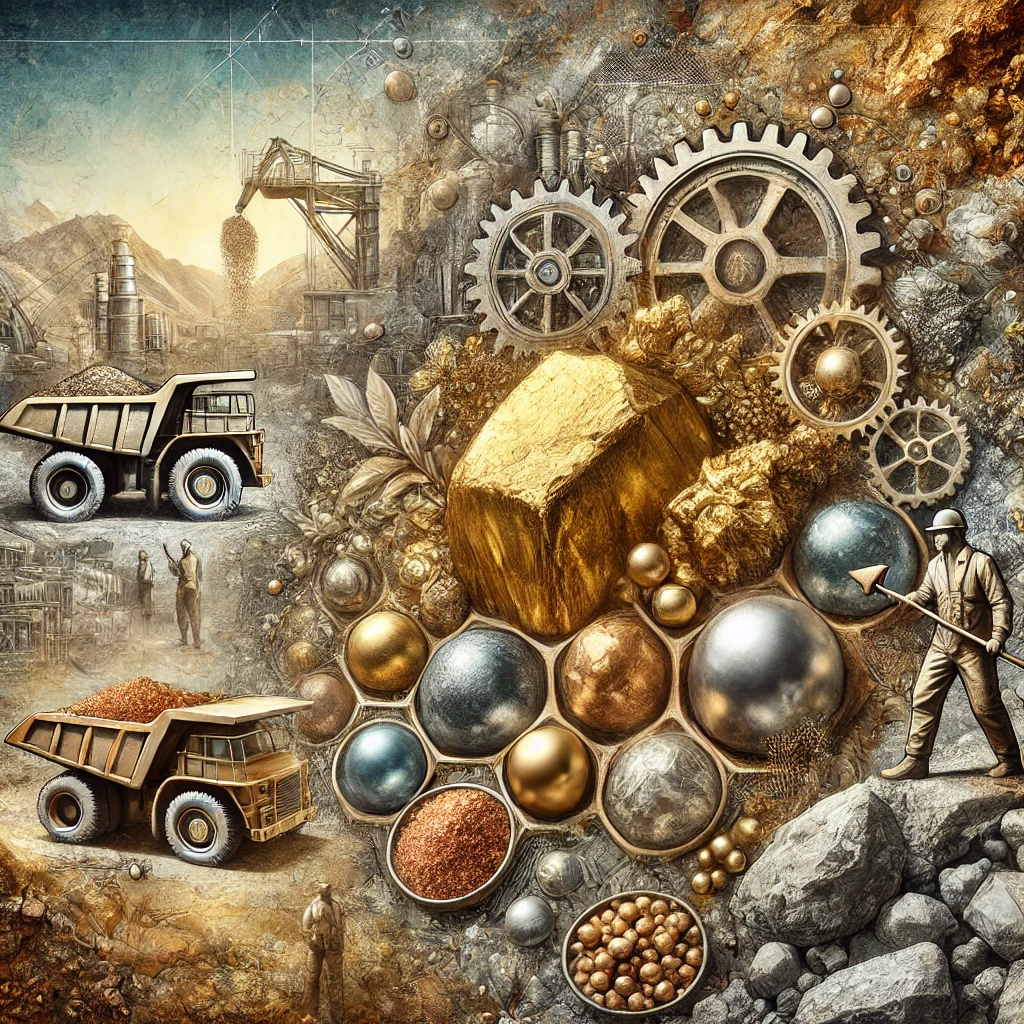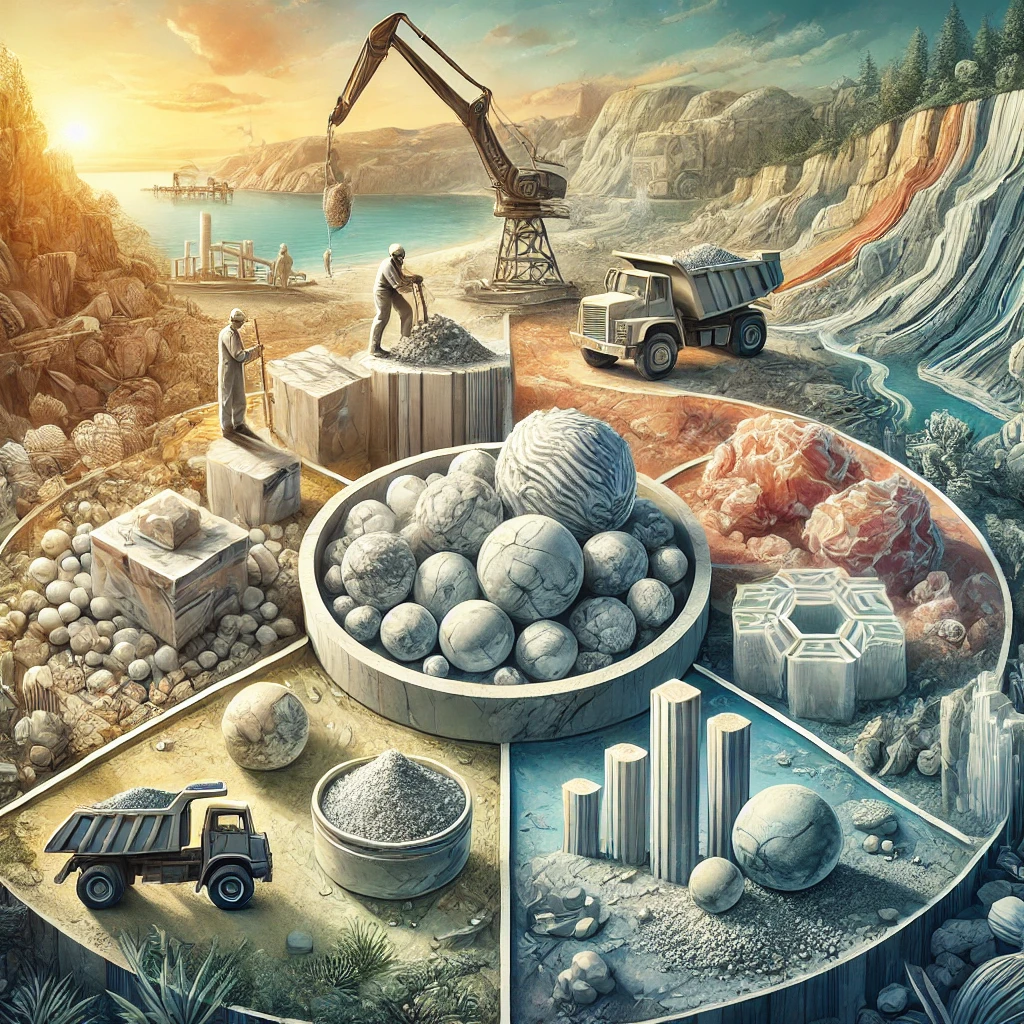
India is one of the richest countries in the world in terms of mineral resources. Various types of minerals are found here , which play an important role in the economic and industrial progress of the country. The mineral resources of India can be mainly classified into metallic , non-metallic and energy-related minerals. Their detailed descriptions are given below:
1. Metallic Minerals
These minerals are used in the production of metals. The major metallic minerals are as follows:
( K) Iron Ore :
- Main areas: Jharkhand , Chhattisgarh , Odisha , Karnataka , and Goa.
- Use: In the steel and other metallurgical industries.
- India is a major exporter of iron ore.
( b) Bauxite :
- Main areas: Odisha , Gujarat , Jharkhand , and Maharashtra.
- Use: In aluminium production.
( G) Manganese :
- Main areas: Madhya Pradesh , Karnataka , and Maharashtra.
- Use: Steelmaking and chemical industries.
( d) Copper :
- Main areas: Rajasthan , Madhya Pradesh , Jharkhand.
- Use: Electrical equipment and construction.
( e) Gold :
- Main areas: Karnataka (Kolar Gold Fields) , Andhra Pradesh.
- Use: Jewellery manufacturing and investment.
2. Non-Metallic Minerals
These minerals are used in non-metallic industries.
( K) Limestone :
- Main areas: Madhya Pradesh , Rajasthan , Andhra Pradesh.
- Use: Cement manufacturing and chemical industries.
( b) Mica :
- Main areas: Jharkhand , Bihar , Rajasthan.
- Use: In the electrical industry.
- India is the largest producer and exporter of mica.
( G) Graphite :
- Main areas: Odisha and Jharkhand.
- Use: Battery and electroplating industry.
( d) Dolomite :
- Main areas: Chhattisgarh , Odisha.
- Use: Steel and glass industries.
3. Energy Minerals
These minerals are used for energy production.
( K) Coal :
- Main areas: Jharkhand (Jharia and Bokaro) , Odisha , Chhattisgarh.
- Use: Power generation and steel industry.
- India is the world leader in coal production.
( b) Petroleum :
- Main areas: Mumbai High , Gujarat , Assam.
- Use: Fuels and Petrochemicals.
( G) Natural Gas :
- Main areas: Assam , Tripura , Gujarat.
- Use: Cooking gas and fertilizer manufacturing.
( d) Uranium :
- Main areas: Jharkhand (Jaduguda).
- Use: Nuclear power generation.
Characteristics of the distribution of mineral resources of India
- Uneven distribution:
Mineral resources are unevenly distributed across the country. They are mainly produced in large quantities in eastern and central India. - Utilization of Mineral Resources:
India’s mineral resources are utilised in both domestic and international markets. - Impact on Industry:
Mineral resources are the base for various industries of the country such as steel , power , construction , and chemical industries. - Environmental impacts:
Mining activities have negative impacts on the environment , such as deforestation , soil erosion and water pollution.
conclusion
India’s mineral resources are extremely important for the country’s economic prosperity. Through their proper use and conservation, the country’s industrial and social development can be further promoted. Also , keeping sustainable development in mind, it is important to balance the mining industry with environmental protection.
Metallic Minerals

Metallic minerals are those minerals that contain metallic elements. These minerals are mainly used for the production of metals and play an important role in industrial and economic development. Metallic minerals can be mainly divided into two categories:
- Ferrous Minerals :
These minerals are rich in iron or ferrous elements. - Minerals :
These do not contain iron , but other important metals like copper , aluminium etc. are found in them.
Below is given a detailed description of the major metallic minerals found in India:
1. Iron Ore
- Importance:
It is the most important ferrometallic mineral of India. It is the basic raw material for the steel industry. - Major types:
- Hematite : High iron content ( 60-70%) .
- Magnetite : High iron content ( 70%) and magnetic properties.
- Main areas:
- Jharkhand (Singhbhum) ,
- Odisha(Kendujhar and Sundergarh) ,
- Chhattisgarh (Bastar) ,
- Karnataka (Chikmagalur , Bellary).
- Uses:
In making steel and other alloys.
2. Manganese
- Importance:
Manganese is an important component in steel making and is also useful in the battery and chemical industries. - Main areas:
- Madhya Pradesh (Balaghat) ,
- Maharashtra (Nagpur) ,
- Karnataka (Udupi).
- Use:
- To harden the steel.
- In the chemical industry and glass manufacturing.
3. Bauxite
- Importance:
It is the main mineral for the production of aluminium. - Main areas:
- Odisha(Kalahandi , Koraput) ,
- Gujarat ,
- Jharkhand ,
- Maharashtra.
- Use:
- Aluminum production.
- Aircraft manufacturing , packaging and electrical equipment.
4. Copper
- Importance:
Copper is an important metal for electrical and communication equipment. - Main areas:
- Rajasthan (Khetri) ,
- Madhya Pradesh (Balaghat) ,
- Jharkhand.
- Use:
- In electric wires.
- In making alloys like brass and bronze.
5. Gold
- Importance:
Gold is useful for jewellery , currency and investment. - Main areas:
- Karnataka (Kolar Gold Fields) ,
- Andhra Pradesh ,
- Jharkhand.
- Use:
- Jewellery and currency.
- Electronics and medical equipment.
6. Zinc and Lead
- Importance:
- Zinc is useful in making steel rust free.
- Lead in the battery and paint industries.
- Main areas:
- Rajasthan (Jawar Khan).
- Use:
- Batteries , paints and alloys.
7. Chromite
- Importance:
Chromium is used for hardening steel and in the chemical industry. - Main areas:
- Odisha (Balasore , Cuttack).
- Use:
- Stainless steel and pigment production.
Areas of use of metallic minerals
- Industrial Area:
- Steel and aluminium industries.
- electric field:
- Electrical equipment manufacturing.
- chemical industry:
- Fertilizer , colour and paint manufacturing.
- Jewellery Industry:
- Gold , Silver, and Platinum.
Importance of metallic minerals in India
- Economic Contribution:
Mineral resources contribute significantly to India’s GDP. - Base for Industry:
Metallic minerals are the backbone of the country’s industrial development. - Exports:
India is a major exporter of many metallic minerals such as iron ore. - Employment:
The mineral mining and processing industry provides employment to millions of people.
Challenges and Solutions
- Challenges:
- Uneven distribution of mineral resources.
- Environmental impact.
- Illegal mining.
- Solution:
- Adoption of sustainable mining practices.
- Efficient use of mineral resources.
- Strict regulations for environmental protection.
Conclusion:
Metallic minerals play a central role in India’s industrial , economic and social progress. Their judicious use and conservation will ensure India’s prosperity in the future.
Non-Metallic Minerals

Non-Metallic Minerals There are minerals in which metallic elements are not found. These minerals are very important for industrial and chemical use. Non-metallic minerals are used in construction , agriculture , chemicals , and various industries.
Characteristics of non-metallic minerals
- These minerals do not have metallic luster and high density.
- These are poor conductors of electricity and heat.
- They are used mainly in industrial and chemical processes.
Major non-metallic minerals in India and their description
1. Limestone
- Importance:
Limestone is mainly used in the production of cement and lime. - Main areas:
- Madhya Pradesh (Katni , Satna) ,
- Rajasthan (Chittorgarh) ,
- Andhra Pradesh ,
- Tamil Nadu.
- Use:
- Cement industry.
- Lime manufacture in the chemical industry.
- For cleaning metals in the steel industry.
2. Mica
- Importance:
Mica is an excellent electrical insulator and heat resistor. - Main areas:
- Jharkhand (Giridih) ,
- Rajasthan (Jaipur , Ajmer) ,
- Bihar.
- Use:
- In electrical equipment.
- In the cosmetics and paint industry.
- As an insulation material.
- India’s Contribution:
India is the largest producer and exporter of mica.
3. Graphite
- Importance:
Graphite is used in batteries and electrical devices. - Main areas:
- Jharkhand ,
- Odisha ,
- Tamil Nadu.
- Use:
- To make the tip of a pencil.
- In batteries and electrodes.
- In the lubricant and chemical industry.
4. Dolomite
- Importance:
Dolomite is an important non-metallic mineral , useful in the steel and glass industries. - Main areas:
- Chattisgarh ,
- Odisha ,
- Rajasthan.
- Use:
- In the steel industry.
- Glass manufacturing.
- Chemical industry.
5. Silica
- Importance:
Silica is used in glass and cement industries. - Main areas:
- Rajasthan ,
- Gujarat.
- Use:
- Glass manufacturing.
- Ceramic and cement production.
6. Gypsum
- Importance:
Gypsum is used in fertilizer and cement industries. - Main areas:
- Rajasthan (Bikaner , Nagaur) ,
- Jammu and Kashmir ,
- Tamil Nadu.
- Use:
- Cement production.
- To increase soil fertility in agriculture.
7. Fluorite
- Importance:
It is a major chemical mineral. - Main areas:
- Rajasthan.
- Use:
- In the aluminum and steel industry.
- In dental products.
8. Asbestos
- Importance:
It is a strong and malleable mineral. - Main areas:
- Rajasthan ,
- Jharkhand.
- Use:
- Insulation material.
- In roofing and pipe construction.
9. Kaolin :
- Importance:
It is useful in ceramic and paper industries. - Main areas:
- Rajasthan ,
- West Bengal.
- Use:
- Ceramics and paper manufacturing.
Importance of non-metallic minerals in India
- Industrial base:
- These minerals are the basis of industries such as cement , glass , ceramics , and paints.
- Chemical Uses:
- Limestone , gypsum , and fluorite are major contributors to the chemical industry.
- Contribution to Agriculture:
- Gypsum and other minerals are used to increase the fertility of the soil.
- Foreign Exchange Earnings:
- The country earns foreign exchange by exporting minerals like mica and graphite.
Challenges and Solutions
Challenges:
- Uneven distribution of minerals.
- Illegal mining and environmental damage.
- Rapid exploitation of mineral resources.
Solution:
- Adherence to sustainable mining practices.
- Mineral conservation and development of alternative means.
- Environmental rehabilitation after mining.
conclusion:
Non-metallic minerals play a vital role in the industrial and economic development of India. Their judicious use and conservation is essential for the sustainable development of the country. Also , better management of mineral resources can be ensured by adopting environmentally-sensitive mining policies.
Characteristics of The Distribution of Mineral Resources of India
India is one of the richest countries in the world in terms of mineral resources. Various types of minerals are found here , which are distributed in different areas depending on geography , climate and geological structures. The main features of the distribution of mineral resources of India are as follows:
1. Uneven Distribution
- Mineral resources in India are not evenly distributed throughout the country.
- Areas of eastern and central India such as Jharkhand , Odisha , Chhattisgarh , and Madhya Pradesh are famous for mineral wealth.
- Non-metallic minerals are found in abundance in western states like Rajasthan , Gujarat , and Maharashtra.
Example:
- Iron Ore : In Odisha , Jharkhand and Chhattisgarh.
- Coal : In Jharkhand , West Bengal , and Chhattisgarh.
- Bauxite : In Odisha and Gujarat.
2. Mineral Belts
Mineral resources in India are mainly distributed in four mineral belts:
( K) North-Eastern Mineral Belt:
- includes Jharkhand , West Bengal , and Odisha.
- Major Minerals: Coal , iron ore , manganese , bauxite.
( b) Southern Mineral Belt:
- includes Karnataka , Andhra Pradesh , and Tamil Nadu.
- Major Minerals: Gold , iron ore , chromite.
( G) Western Mineral Belt:
- Rajasthan and Gujarat are included in this.
- Major Minerals: Limestone , gypsum , mica.
( d) Central Indian Mineral Belt:
- includes Madhya Pradesh , Chhattisgarh , and Maharashtra.
- Major Minerals: Manganese , coal , and copper.
3. Distribution according to geological structure
The geological structure of India has a profound influence on the distribution of mineral resources:
- Dharwar Craton: Iron ore , manganese, and gold are found in the ancient rocks.
- Gondwana Rock Group: The largest reserves of coal are found here.
- Vindhyan Rock Group: Non-metallic minerals like limestone and dolomite are found here.
4. Regional distribution of metallic and non-metallic minerals
- Metallic Minerals:
- are mainly found in Jharkhand , Odisha , Chhattisgarh , and Karnataka.
- Example: Iron ore , manganese , copper.
- Non-metallic minerals:
- are found mostly in Rajasthan , Gujarat , and Tamil Nadu.
- Example: Limestone , gypsum , mica.
5. Special distribution of energy minerals
- Coal:
- In the Gondwana regions of Jharkhand , Odisha , West Bengal , and Chhattisgarh.
- Petroleum and Natural Gas:
- Assam , Gujarat , and Mumbai High.
- Uranium:
- In Jharkhand(Jaduguda).
6. Influence of climatic and geographical factors
- Northeast India:
- Areas with high rainfall pose challenges to mineral storage and mining.
- Thar Desert:
- This region of Rajasthan is famous for non-metallic minerals like gypsum and mica.
7. Mineral distribution in some major states
( K) Jharkhand:
- iron ore , coal , manganese , and mica.
- Singhbhum and Dhanbad are the major mining areas.
( b) Odisha:
- Major mineral producing state of India.
- Iron ore , chromite , bauxite and coal.
( G) Rajasthan:
- Limestone , gypsum , and fluorite.
- Desert areas are rich in non-metallic minerals.
( d) Karnataka:
- Gold (Kolar Gold Fields) , Iron Ore.
( e) Madhya Pradesh:
- Copper , manganese , and dolomite.
8. Problems related to distribution of mineral resources
- Uneven Distribution of Minerals:
- Some areas have abundant mineral wealth while other areas are deficient in it.
- Rapid Exploitation of Minerals:
- Due to high demand, mineral resources are being exploited indiscriminately.
- environmental damage:
- Mining activities are causing deforestation , soil erosion and water pollution.
9. Measures to improve distribution
- Balanced Mineral Policy:
- To ensure judicious utilisation of mineral wealth.
- Mineral Conservation:
- Sustainable mining and development of alternative resources.
- Value Addition of Mineral Resources:
- Establishment of mineral processing units.
- Environmental protection:
- Post mining land rehabilitation and tree planting.
conclusion The distribution of India’s mineral resources is uneven , but their diversity and quantity provide the country with a strong basis for industrial and economic development. Their proper use through sustainable mining and environmental protection can make India’s future even brighter.
